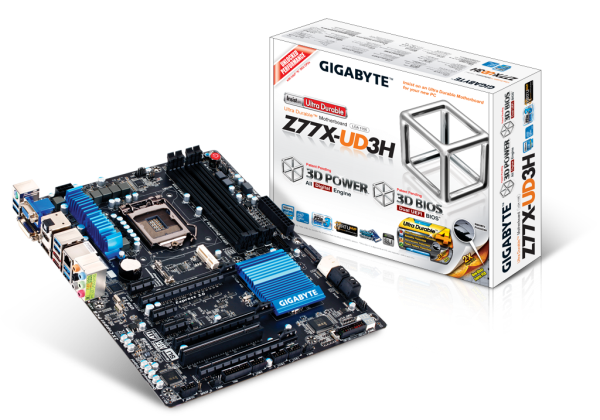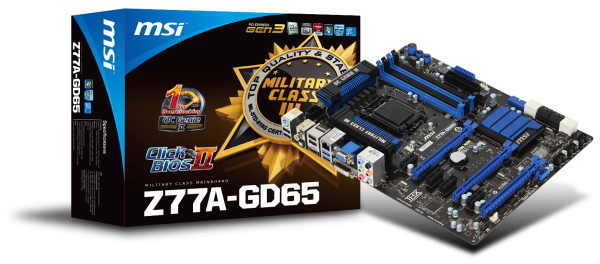Intel Z77 Motherboard Review with Ivy Bridge - ASRock, ASUS, Gigabyte, and MSI
by Ian Cutress on May 7, 2012 7:40 PM EST- Posted in
- Motherboards
- MSI
- Gigabyte
- ASRock
- Asus
- Ivy Bridge
- Z77
Conclusion – Gigabyte GA-Z77X-UD3H
What does a user want from a motherboard? The holy grail of motherboard questions without one distinct, definitive answer. If one user wants a certain feature, another user will not want it nor will they want it on the product as it could introduce cost. So when a motherboard manufacturer draws up a list of future products, what determines which products they sell? Cost? Market research? Previous experience?
From my perspective, we need a motherboard that works out of the box. Suffice to say, the Gigabyte Z77X-UD3H does work out of the box, as long as you are not using G.Skill memory on the F2 BIOS. Upgrade to the F7 BIOS, and we have a board that hits the price bracket at around $160. For $160, we get a full set of video outputs, an mSATA port, a TPM header, power/reset buttons (with debug LED), dual graphics card support, and a rather different combination of audio/NIC compared to other products.
Nevertheless, the board performs well in our testing suite, and is especially the best in terms of minimal voltage ripple to our CPU.
Conclusion – MSI Z77A-GD65
The MSI Z77A-GD65 will be MSI's number two board, behind the supposedly Thunderbolt equipped Z77A-GD80 released later this year, and the GD65 is currently retailing for $190, between the Gigabyte and the ASUS. For the price we lose PCI and mSATA over the Gigabyte, but gain SATA, an Intel NIC, a clear CMOS button on the IO panel, and arguably easier to use software and BIOS implementations (from this reviewers standpoint).
From a performance perspective, to get into the upper ranges of the other motherboards in this review, it is advised that users enable OC Genie to get a 200 MHz frequency bump when all cores are fully loaded. This would help with strenuous multithreaded workloads. In comparison, for rigorous overclocks, manual adjustment is required.
The MSI Z77A-GD65 is an easy to use product that has all the video outputs. As a kicker, it uses the lowest voltage at load than any other motherboard.












117 Comments
View All Comments
faizoff - Monday, May 7, 2012 - link
Are Q connectors proprietary of ASUS? I seem to find those only their motherboards. Love them to death.Great review. I enjoy these tremendously. Almost makes me go out and upgrade my i5 2500k.
Impulses - Monday, May 7, 2012 - link
My MSI P67A-GD55 has the same thing, unfortunately the connector block is too tall and bumps into my second 6950 so I couldn't use it.eBob - Tuesday, May 8, 2012 - link
I, too, am a fan of the Q Connector mostly for the front panel connections (power, reset, HDD light). The USB and audio connectors seem to be pretty well standardized at this point, rendering those Q Connectors redundant IMO. This would seem to be a very simple and inexpensive feature for a mobo manufacturer to have (at least for the front panel connector).bji - Monday, May 7, 2012 - link
Thank you for including this important benchmark. I hope that every motherboard review going forward will include this.The ASRock has the best time but 8 seconds is still too long. I wonder why BIOS developers can't get their act together and initialize hardware in parallel. That would surely speed POST times up tremendously.
adrianlegg - Monday, May 7, 2012 - link
I've been struggling about that issue myself. I mean - it probably was in times of BIOS, but now, with all fancy UEFI is it really that hard? (considering more resources spent on bios/uefi in mobo)Altough I'm not big fan of 200$+ motherboards, I would seriously consider buying one if it POST in 2s.
Even though there are probably POST requirements such as cpu cant be tested before ram or opposite it would be awesome to have really low boot times.
Sad when even having SSD cant give You instant full boot (not hibernations/sleeps).
It's one of those small features that are soo awesome (like reset/power buttons, and perhaps, in future : complete per component (ram/disk/SB/NB/coolers) power usage).
Nevertheless 8seconds is damn nice.
EnzoFX - Monday, May 7, 2012 - link
Does anyone know how enabling AHCI in the UEFI affect post time these days? I'd like to remove the other 7-10 seconds this adds to it.pixelstuff - Monday, May 7, 2012 - link
How do those Chromebooks shave time off of the POST? Seems like similar techniques could be implemented unless there is a good reason not to.rahvin - Tuesday, May 8, 2012 - link
Chromebooks use OpenBIOS IIRC. OpenBIOS is Linux Kernel based and boots very fast because it initializes things quicker and it's custom built to the hardware on the board. Personally I wish all the Boards would start using it and toss these BIOS down the hole of history.DanNeely - Tuesday, May 8, 2012 - link
They've got a very stripped down set of hardware to initialize. The more stuff you have on board, the longer it takes. EFI was supposed to fix this by allowing multi-threaded boot (BIOS was strictly a single threaded design); but either firmware makers aren't generally taking advantage of it yet, or dependencies in the startup process are limiting the gains.Jase89 - Sunday, May 19, 2013 - link
Don't forget the graphics card (if using discrete) will need to support UEFI (GOP) Booting too!